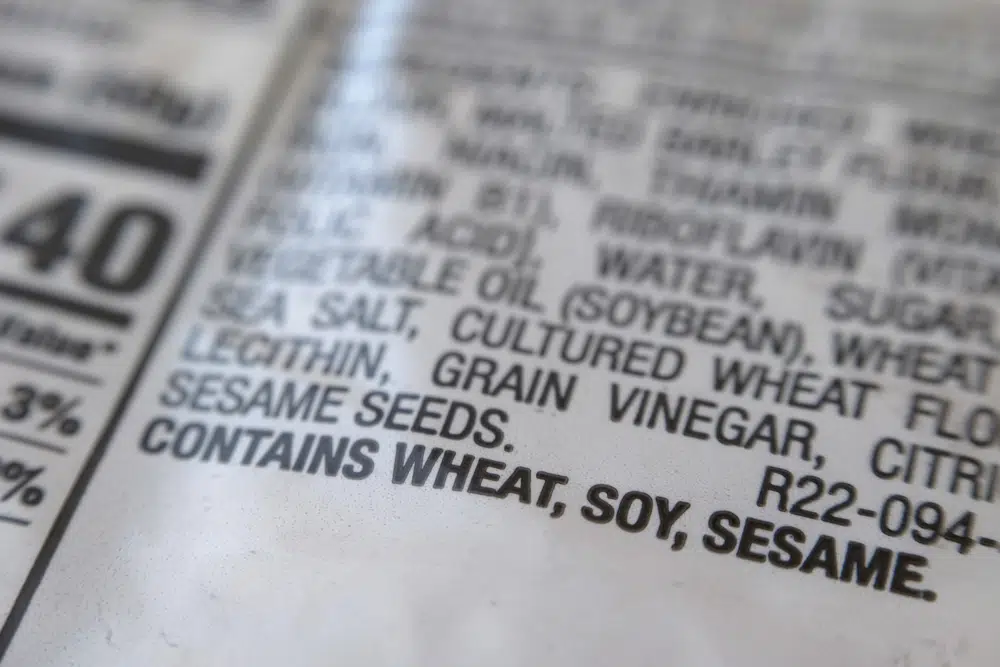A notification for sesame is printed under the ingredient list on a bag of hot dog buns in New York on Wednesday, Dec. 21, 2022. A new federal law requiring that sesame be listed as an allergen on food labels is having unintended consequences _ increasing the number of products that include the ingredient. Starting Jan. 1, all foods made and sold in the U.S. must be labeled if they contain sesame, an often-hidden ingredient that’s been declared the nation’s ninth major allergen. (AP Photo/Patrick Sison)
A new federal law requiring that sesame be listed as an allergen on food labels is having unintended consequences — increasing the number of products with the ingredient.
Food industry experts said the requirements are so stringent that many manufacturers, especially bakers, find it simpler and less expensive to add sesame to a product — and to label it — than to try to keep it away from other foods or equipment with sesame.
As a result, several companies — including national restaurant chains like Olive Garden, Wendy’s and Chick-fil-A and bread makers that stock grocery shelves and serve schools — are adding sesame to products that didn’t have it before. While the practice is legal, consumers and advocates say it violates the spirit of the law aimed at making foods safer for people with allergies.
“It was really exciting as a policy advocate and a mom to get these labels,” said Naomi Seiler, a consultant with the Asthma and Allergy Foundation of America whose 9-year-old daughter, Zoe, is allergic to sesame. “Instead, companies are intentionally adding the allergen to food.”
The new law, which goes into effect Jan. 1, requires that all foods made and sold in the U.S. must be labeled if they contain sesame, which is now the nation’s ninth major allergen. Sesame can be found in obvious places, like sesame seeds on hamburger buns. But it is also an ingredient in many foods from protein bars to ice cream, added to sauces, dips and salad dressings and hidden in spices and flavorings.
Advocates for families coping with allergies lobbied for years to have sesame added to the list of major allergens. Congress in 2004 created labeling requirements for eight: milk, eggs, fish, shellfish, tree nuts, peanuts, wheat and soybeans.
More than 1.6 million people in the U.S. are allergic to sesame, some so severe that they need injections of epinephrine, a drug used to treat life-threatening reactions. Cases of sesame allergy have been rising in recent years along with a growing number of foods that contain the ingredient, said Dr. Ruchi Gupta, a pediatrician and director of the Center for Food Allergy & Asthma Research at Northwestern University.
“Sesame is in so many things that people don’t really understand,” said Gupta, who called the move to add sesame to products “so disappointing.”
“In families that do have a sesame allergy, it is truly challenging,” she said.
Under the new law, enforced by the Food and Drug Administration, companies must now explicitly label sesame as an ingredient or separately note that a product contains sesame. In the U.S., ingredients are listed on product packaging in order of amount. Sesame labeling has been required for years in other places, including Canada, Europe, Australia and New Zealand.
If the ingredients don’t include sesame, companies must take steps to prevent the foods from coming in contact with any sesame, known as cross-contamination.
Food industry experts said the new requirements aren’t simple or practical.
“It’s as if we’ve suddenly asked bakers to go to the beach and remove all the sand,” said Nathan Mirdamadi, a consultant with Commercial Food Sanitation, which advises the industry about food safety.
Some companies include statements on labels that say a food “may contain” a certain product or that the food is “produced in a facility” that also uses certain allergens. However, such statements are voluntary, not required, according to the FDA, and they do not absolve the company of requirements to prevent cross-contamination.
Instead, some companies have taken a different approach. Officials at Olive Garden said that starting this week, the chain is adding “a minimal amount of sesame flour” to the company’s famous breadsticks “due to the potential for cross-contamination at the bakery.”
Chick-fil-A has changed its white bun and multigrain brioche buns to include sesame, while Wendy’s said the company has added sesame to its French toast sticks and buns.
United States Bakery, which operates Franz Family Bakeries in California and the Northwest, notified customers in March that they would add a small amount of sesame flour to all hamburger and hot dog buns and rolls “to mitigate the risk of any adverse reactions to sesame products.”
Although such actions don’t violate the law, the FDA “does not support” them, the agency said in a statement.
“It would make it more difficult for sesame allergic customers to find foods that are safe for them to consume,” the statement said.
Some large companies previously have added other allergens to products and updated their labels. In 2016, Kellogg’s added traces of peanut flour to some cookies and crackers, prompting protests.
That’s frustrating and scary for parents like Kristy Fitzgerald of Crookston, Minnesota. She learned last spring that Pan-O-Gold Baking Co., which supplies breads to schools, health centers and grocery stores across the Midwest, was adding small amounts of sesame to its products, including those served at her daughter’s school. Six-year-old Audrey, in the meantime, has outgrown her allergy to sesame.
Bob Huebner, food safety/quality assurance manager for Pan-O-Gold, told Fitzgerald in a string of emails that the company was forced to add sesame to the product and the label.
“The unfortunate reality is that our equipment and bakeries are not setup for allergen cleanings that would be required to prevent sesame cross-contamination and was not an option for us,” Huebner wrote in an email to Fitzgerald. Huebner replied to an email from the AP but did not respond to questions about the company’s practices.
Fitzgerald started an online petition protesting the move to add sesame.
“At some point, someone is going to feed an allergic child sesame,” Fitzgerald said. “It makes me think the laws need to change to show that this is not an acceptable practice.”
—-
The Associated Press Health and Science Department receives support from the Howard Hughes Medical Institute’s Science and Educational Media Group. The AP is solely responsible for all content.
Copyright 2021 Associated Press. All rights reserved.
Source: https://apnews.com/article/sesame-allergies-label-b28f8eb3dc846f2a19d87b03440848f1









































